Roman Coins; Military Crisis of the 3rd Century Part II
Barbarian Invasions & The Breakup into 3 Separate Empires
At this time the Roman Empire was faced with many calamities
The regular Roman Empire with Gallienus, then Claudius II as Emperors
click on the coin for a view of both sides
| pictures of coin | coin notes | history notes |
|
Sleipnir of Nordic Legend 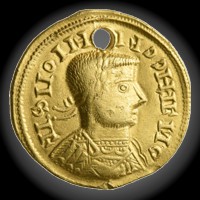 Germanic imitation aureus unidentifiable Emperor portrait / Sleipnir: the 8 legged horse of Odin Leu Numismatik auct 7, 24 October, 2020, lot 1909 |
Aurum Barbarorum
This is a Gothic or Germanic imitation of a Roman gold aureus. While exactly which Emperor is depicted on the obv cannot be clearly determined, the engraver put the 8 legged horse of Nordic legend, Sleipnir, on the reverse. Sleipnir was exclusively ridden by Odin: the Norse God, except on one occasion when {I believe} he was loaned out to someone for a trip to the underworld. Thus presumably it is Odin shown on the reverse riding Sleipnir. It {he} was the fastest horse around; no doubt due to the 8 legs. All 3 of the specimens of this coin are holed. They were made as such for wearing by local chieftins or war party leaders. Later, custom gold mounts were made attached to the coins. This coin was presumably made soon after 270 AD after the supply of official captured Roman gold dried up but before pieces with regular mounts instead of holes came into use. |
At the Battle of Abritus (251 AD) a Roman army of 80,000 was lured into a swamp
and destroyed by the Goths. Many of the Romans sank into the mud and the wounded and dead were
unrecoverable. The Goths captured large amounts of Roman aureii and additional coins were given them as tribute. These sources dried up after Aurelian (r. 270 - 275 AD) defeated the Gothic armies. Thus Gothic goldsmiths began to develop local copies of Roman aureii. Leu Numismatik kindly allowed me to reprint their interesting article on the Aurum Barbarorum coinage Aurum Barbarorum Collection An interesting story on the gold aureus of Gallienus produced by stolen dies Also by Leu Numismatik Gallienus aureus from captured dies |
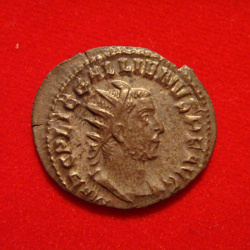 Gallienus r. 253 - 268 A.D. antoninianus, bronze with silver wash bought at a coin show, 1989, wt= 3.339 g |
Gallienus reigned from 253 - 268 A.D. The antoninianus is a double denarius as evidenced by the spiked crown. This coin appears to be very low grade silver but I understand they are bronze with a thin silver surface coating. During this period the antoninianus declined from 20% to 4% silver. This one appears on the outside to be about 10% silver but may be less overall. |
go to http://ettuantiquities.com/Philip_1/Philip1-Antoninianus.htm to see a detailed writeup on the Roman antoninianus. This link & article doesn't work anymore, hoping to get the article to post here. go to gallienus.net to see a website dedicated to the coins (almost entirely antoninianii) of Gallienus. Unfortunately it seems to be gone. Here is another page dedicated to The Age of Gallienus, by Camden W. Percival. It appears under Forvm Ancient Coins. It seems that websites dedicated to Gallienus are as unstable as his reign. |
|
The Sucessionist Gallic Empire [Wikipaedia] From 260 to 271 AD the NorthWest Roman Empire including Britain, Gaul, and Germania, and parts of Hispania were controlled by a rebel Emperor. This Separatist Gallic Empire was created by the general Postumus in command of Britain. The Gallic Emperors were: Postumus, Marius (just a short period), Victorinus, and Tetricus I and II. |
||
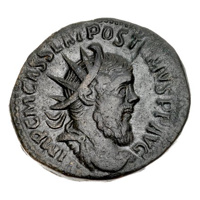
Postumus Emperor 260 - 269 AD double sestersius, Treveri (Trier), issued 261 AD CNG auction 94, 18 Sept 2013, lot# 1194 |
Double Sestertius (33mm, 18.54 g, 5h). |
After a discussion of these on NumisForums, we decided that these coins underwent inflation and the weight reduction indicated difficulty in meeting demands for the numbers required. Treveri, modern Trier, also has the wonderful Porta Nigra city gate and the Landesmuseum which features the 'Golden Hoard' display of ~2,500 aureii as well as an impressive numismatic display of Republican & Imperial coinage. I visited it in 2014. |

Victorinus Emperor 269 - 271 AD antoninianus Frank S. Robinson fixed price list, c.1979 $15. |
photo by Jeff Knee, weight = 1.680 g described in the 70's as crudely made but with much orginal red on surfaces; probably classed as mint state today - or -Beauty is in the eye of the beholder |
|
|
Sucessionist Palmyrene Empire |
||

|
Zenobia & her son Valabanthus led the Palmyrene Empire |
|
|
Restored Roman Empire |
||
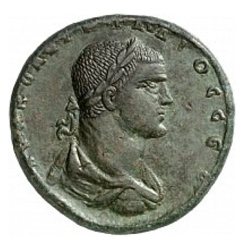
Claudius II r. 268 - 270 A.D. AE 42 medallion of Cyzicus Goldberg's auction, August, 2012 previously their auction in May, 2012 previously Gorney & Mosch, 2011, lot 2139 |
published wt is 49.06g from Goldberg's, I'll have to weigh it to make sure I wasn't cheated out of some bronze. AE medallion from Kyzikos (Cyzicus) obv Claudius II rev Helios (the sun god) in a quadriga |
Claudius II (Gothicus)was Caesar from 268 - 270 AD |
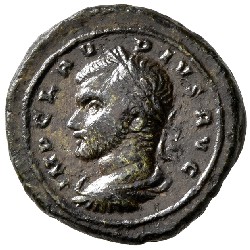
Claudius II r. 268 - 270 A.D. bronze denarius Leu Numismatik, Auction#4, 25 May, 2019, lot# 721 |
Claudius II Gothicus, 268-270. Denarius |
writeup and photo by Leu Numismatik |
 Probus r. 276 - 282 AD antoninianus |
Photo taken with inside lighting. Coin actually appears silver on the outside. wt= 4.097g |
Probus (also Gothicus) was Emperor from 276 - 282 AD. |